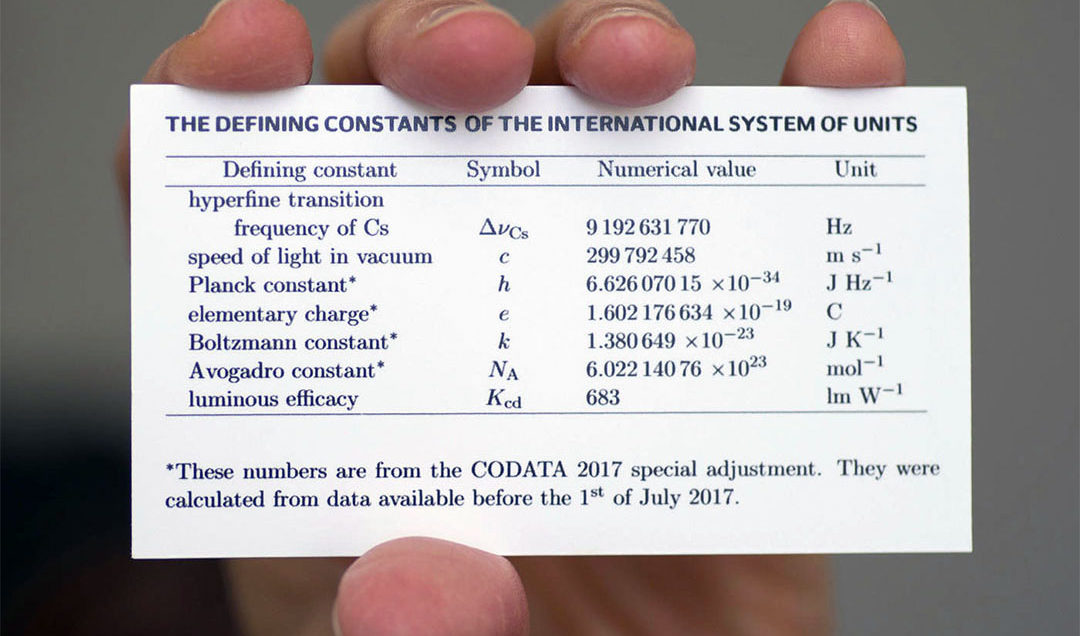
CLEMSON, South Carolina – The way the world measures everything from coffee to the cosmos underwent a profound transformation Friday as a convocation of delegates representing 60 countries voted unanimously to redefine four of the seven base units for the International System of Units, more commonly known as the metric system.
The newly defined units – the kilogram (mass), kelvin (temperature), ampere (electrical current) and mole (amount of substance) – will no longer be determined by comparison to physical objects. Instead, they will now be based entirely on relationships between fundamental constants such as speed of light and the fundamental unit of electric charge, which operate smoothly and consistently from the smallest objects to the far reaches of the universe.
The other three units – the second (time), meter (length) and candela (luminous intensity) – will remain the same because these were already defined with respect to the fundamental constants.
The metric system was officially adopted in 1799. The International System of Units (SI) was established in 1960. The planned rollout of Friday’s revised SI will occur in May 2019.
The vote, which was held during the 26th General Conference of Weights and Measures in Versailles, France, will implement changes that will advance measurement-science for generations to come. Anyone in any place will now be able to precisely measure mass, temperature, electrical current and amount of substance just as accurately as time, distance and luminosity are already measured.
To say the least, scientists are thrilled.
Jon Pratt is chief of the quantum measurements division for the National Institute of Standards and Technology (NIST), a non-regulatory agency of the U.S. Department of Commerce that promotes innovation and industrial competitiveness. In a NIST blog post on Oct. 30, Pratt said that the redefinition of the four base units is the result of decades of groundbreaking laboratory work.
“Humans realized some 230 years ago that perhaps the greatest obstacle to the exchange of objects and ideas, to the pursuit of happiness and progress, to sorting things out, was the lack of a common, universal basis of measurement,” said Pratt, who added that the two industry sectors most likely to benefit fastest from the redefinitions are electronics and pharmaceuticals. “The International System of Units is perhaps humanity’s most grand and successful experiment in cooperation.”
[vid origin=”youtube” vid_id=”21vElKsU3K4″ size=”medium” align=”left”]
According to NIST, humans were measuring things before they learned how to write. They counted things, used the sun to tell time, and based units of length and weight on earthly objects. A NIST video explains how measurements helped humans become merchants, builders, astronomers, navigators, engineers and scientists. The video also points out that the need for better measurements has grown with each new invention.
Though the average person won’t be blatantly affected by the newly defined measurement units, scientists around the world – including at Clemson University – view this as a turning point for humanity.
“The reason for this redefinition is because we are moving into a realm of highly precise devices, whether its quantum computers, nano devices, or a myriad of other examples,” said Chad Sosolik, interim chair in the College of Science’s department of physics and astronomy. “In my research, these changes will show up because what we’re proposing is to build our own version of a single electron device using ions. So we’re constantly doing measurements – and more precise measurements will lead to more effective results.”
According to NIST, when the revised definition of the kilogram is implemented in May 2019, it will be based on three fundamental constants: the Planck constant, the speed of light and the cesium atom’s natural microwave radiation. The Planck constant describes the size of the packets of energy or quanta that atoms and other particles use to absorb and emit energy.

NIST further explains that the current kilogram mass exerts a specific amount of force in Earth’s gravity. The revised definition replaces this determination of mechanical force with an electromagnetic measurement tied to the Planck constant and based on electrical current and voltage. The SI unit for the ampere will now be based on the constant for the charge of the electron. The kelvin will be based on quantum-level measures of atomic motion, while the mole will be based on an improved value for Avogadro’s constant.
“For me, as a scientist, it has always been sort of disturbing that the kilogram would be a physical object in somebody’s possession that could be lost or stolen or manipulated in any kind of way,” added Joan Marler, an assistant professor in the department of physics and astronomy whose research focuses on the individual properties of atoms and molecules as well as the interactions between them and with photons. “It just makes sense that this property should be defined in terms of fundamental constants. Apparatus to determine the values of the units can be made from ground zero at any location. As a scientist, I find this comforting. So I’ll sleep better tonight.”
– Information from the National Institute of Standards and Technology was used throughout this report. For more details on the SI Redefinition, go to https://www.nist.gov/si-redefinition.
Get in touch and we will connect you with the author or another expert.
Or email us at news@clemson.edu

